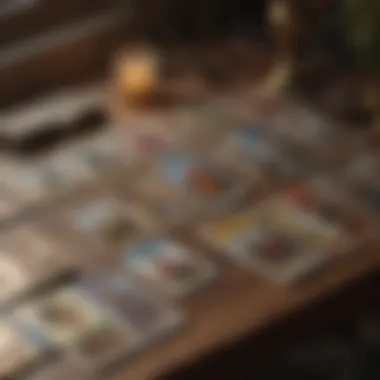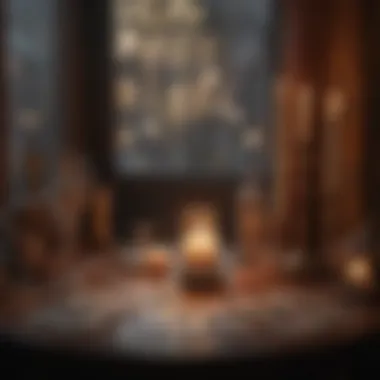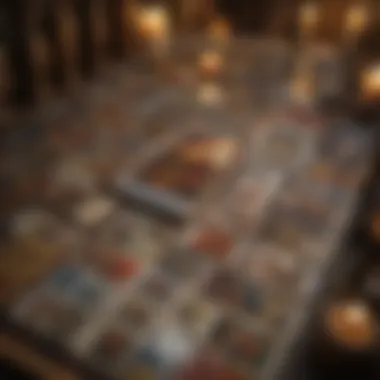Mastering Self Tarot Card Reading Techniques


Intro
Tarot card reading has been a practice for centuries, providing insight and reflection for those who seek guidance. This guide aims to unravel the complexities of self tarot card reading, making the practice accessible for both novices and seasoned readers alike. By comprehensively exploring the foundational principles, methods, and potential benefits of self-reading, individuals can cultivate their intuitive abilities and enhance their personal growth.
Through this journey, the reader will understand what tarot is, its purpose in self-reflection, and the tools required for effective readings. The guide also addresses various card spreads and interpretations, enabling readers to navigate the cards with confidence. Moreover, it highlights common pitfalls that one may encounter in the process, allowing practitioners to approach their readings with enhanced awareness.
The relevance of self tarot card reading extends beyond mere divination; it fosters self-discovery and emotional clarity, making it a valuable asset in anyone's personal development toolkit. As we progress through this guide, we'll delve into multiple aspects of tarot, aiming for a holistic understanding of each component.
Understanding Tarot
In the realm of self tarot card reading, a solid grasp of tarot encompasses the core of engaging with this practice. As one studies tarot, it becomes essential to recognize its historical significance, structure, and emotional depth. Understanding tarot provides clarity on how to interpret the cards, enhancing the reading experience. This comprehension forms the foundation to cultivate intuition and personal insight, essential for any tarot journey.
The Origin and Evolution of Tarot
Tarot's beginnings trace back to the 15th century in Europe, emerging primarily as playing cards. Over time, these cards evolved into a tool for divination, embraced by mystics, psychics, and seekers of wisdom. The transformation of tarot from a simple game to a spiritual guide marks its rich journey through culture and continued relevance today. Its historical context enriches our appreciation for each cards symbolism and enhances the self-reading experience.
The Structure of a Tarot Deck
Major Arcana
The Major Arcana comprises twenty-two cards, each representing pivotal life themes and spiritual lessons. These cards hold substantial power and influence over the reading, often highlighting significant life events or transformative experiences. Their presence often indicates major shifts or revelations within the person's life, making them crucial for self-reflection. The Major Arcana connects the reader to deep archetypal energies, providing profound insights into the human experience.
Minor Arcana
The Minor Arcana consists of fifty-six cards divided into four suits: Wands, Cups, Swords, and Pentacles. Each suit addresses everyday experiences, thoughts, and emotions. They symbolize the nuances of daily life, ensuring that tarot readings encompass a broad spectrum of human experience. The Minor Arcana can provide guidance on various aspects of life, from relationships to career, making them indispensable for comprehensive self-exploration.
Suits and Their Meanings
The suits within the Minor Arcana carry unique meanings that reflect different elements of existence.
- Wands represent action, ambition, and creativity. They often speak to inspiration and the drive to achieve.
- Cups symbolize emotions, relationships, and connections. This suit helps navigate feelings and interpersonal dynamics.
- Swords deal with thoughts, conflict, and challenges. They provide insights into mental struggles and decision-making.
- Pentacles connect to the material realm, focusing on financial and physical matters. They guide on practical aspects of life.
Understanding these suits is essential for their interpretations, allowing readers to draw parallels with their personal life experiences.
The Role of Intuition in Tarot
Intuition plays a vital role in tarot reading. Each individual carries unique insights that shape their understanding of the cards. Recognizing and nurturing one's intuition allows for a more profound connection to the deck. This intuitive approach fosters a collaborative relationship with the cards, guiding readers beyond standard meanings. It encourages a personalized interpretation that aligns with individual experiences, elevating the practice of tarot reading to a deeply personal tool for growth and understanding.
Why Self Tarot Reading Matters
Self tarot reading offers profound benefits that extend beyond mere card interpretations. Engaging in this practice can lead to a deeper understanding of oneself and one’s circumstances. It emphasizes personal growth and empowerment. Instead of relying on external influences for guidance, individuals can turn inward, exploring their thoughts and emotions through the lens of tarot.
Among the key elements to consider are the following:
- Clarity in decision-making.
- Heightened emotional awareness.
- Opportunity for self-growth.
By tapping into the intuitive aspects of tarot, individuals can uncover insights that may be overlooked in their daily lives. This practice fosters an environment for personal exploration and understanding, revealing motivating factors and hidden feelings.
Personal Insight and Reflection
Self tarot reading is a tool for personal insight and reflection. It allows individuals to confront their thoughts, feelings, and behaviors in a structured way. Each card drawn can serve as a mirror, reflecting different facets of one’s life. This process encourages mindfulness and moments of pause in an often chaotic world.
Reflecting on the cards can enhance self-awareness, helping to identify patterns in one’s life. It prompts individuals to ask questions, such as:
- What opportunities are available to me?
- How do my past experiences shape my present?
By engaging thoughtfully with the cards, practitioners can discover aspects of themselves that may require healing or nurturing.
Self-Exploration and Understanding
Self-exploration is essential for growth. Tarot reading can aid in this process by guiding individuals to confront issues they may avoid. Each suit and card presents unique challenges and themes. By exploring these, individuals gain insights into their motivations and behavior.
These are some examples of how tarot can facilitate self-exploration:
- Uncovering suppressed emotions: Cards can reveal feelings that have been hidden.
- Acknowledging personal desires: It supports clarity in aspirations and dreams.
- Examining relationships: Tarot explores dynamics with family, friends, and partners.
Through this exploration, practitioners can foster a sense of understanding, allowing for personal development and improved relationships.


Emotional Healing and Growth
Emotional healing is a key aspect of self tarot reading. The cards often illuminate wounds that need attention. By acknowledging these wounds, individuals can begin to work towards healing. Each reading offers a chance to process emotions and experiences in a safe space.
Some insightful outcomes of emotional healing through tarot include:
- Improved self-compassion: Cultivating kindness towards oneself.
- Strategic coping mechanisms: Developing ways to cope with emotional challenges.
- Resilience: Learning to bounce back from setbacks.
As one continues to engage with self tarot readings, emotional growth becomes a natural progression. A deeper connection with oneself lays the foundation for ongoing healing and transformation.
"Through self tarot reading, you reclaim your power, guiding your path forward."
Preparing for a Self Reading
Preparing for a self reading is a crucial step that can greatly influence the quality and clarity of your tarot experience. Engaging with tarot is not just about drawing cards; it is about fostering a deep connection between you and the deck. This section will highlight key elements such as selecting the right tarot deck, creating a conducive environment, and defining your intentions. Each of these aspects is essential in enhancing your self reading practice and ensures that the readings resonate with your personal journey.
Choosing Your Tarot Deck
The selection of a tarot deck is more than a mere preference. It is a reflection of your energy, interests, and intuition. Different decks offer unique artistic interpretations of the cards, which can lead to varied emotional responses during readings. When selecting a deck, consider the following:
- Personal Connection: Choose a deck that speaks to you visually and emotionally. This connection can help you interpret the cards with greater depth.
- Art Style: Tarot decks come in many styles, from traditional to modern or abstract. Picking a style that resonates with your personal aesthetics will enhance your readings.
- Card Material and Size: The tactile experience of handling cards is important. Some prefer a sturdy card stock, while others may favor a lighter deck for ease of shuffling. The size can also affect your comfort level when working with the cards.
Many well-known decks like the Rider-Waite-Smith and the Thoth Tarot are recommended for beginners due to their rich symbolism and widespread use in literature. However, it's also valuable to explore indie decks that may resonate more strongly with your unique journey.
Creating a Sacred Space
A sacred space acts as a container for your reading practice. It helps in focusing your energy and intention. Here are ways to create such an environment:
- Location: Find a quiet spot free from distractions. This could be a corner of a room or even an outdoor space where you feel at peace.
- Set the Mood: Consider adding elements like candles, crystals, or incense to elevate the atmosphere. Soft lighting can also create an inviting environment.
- Clear the Area: Before starting a reading, clear the energy of the space. You can do this through simple rituals like burning sage or ringing a bell. This practice helps to eliminate unwanted energies that may affect your reading.
Taking the time to create a sacred space is an investment in your self-care and self-discovery journey.
Setting Intentions for the Reading
Setting clear intentions is a powerful practice that guides your reading process. Intentions help focus your mind and heart, providing a framework for the insights you'll receive. Here’s how to effectively set your intentions:
- Be Specific: Instead of vague intentions like "I want to know about my future," specify the area you want guidance on, such as "I want insight into my career path."
- Write It Down: Consider jotting down your intentions beforehand in a journal. This act of writing reinforces your commitment to seeking clarity.
- Affirm Positive Energy: Frame your intention in a positive light. For example, instead of saying, "What if I fail?" reframe it as, "How can I succeed on my journey?"
Setting intentions is not just about the cards. It’s about the mindset you bring to your practice.
Card Spreads for Self Reading
Understanding card spreads is essential for self tarot reading. A card spread organizes the cards in a way that enhances the clarity and depth of interpretations. Each spread serves a unique purpose, providing insights into various aspects of life, such as decisions, emotions, or past experiences. The selection of a card spread is often influenced by the reader's questions, intentions, and the complexity of the query.
The benefits of using specific card spreads are significant. They guide the reader to focus their thoughts and intentions clearly, allowing for more meaningful reflections. For individuals beginning their tarot journey, being familiar with various spreads can help to illuminate the personal meanings behind the cards drawn. It also fosters a systematic approach to reading, making it easier to document and analyze insights over time.
Single Card Draw
The single card draw is one of the simplest and most direct spreads in tarot reading. This method is ideal for gaining quick insights or answering specific questions with clarity. With just one card, the reader can focus their interpretation solely on the immediate message or energy represented in that chosen card.
This technique offers a straightforward way to engage with the tarot. It encourages a deep concentration on that single image, allowing for focused reflection. The simplicity of this spread is its primary characteristic, making it accessible for both beginners and experienced readers. However, its limited scope means it may not provide a comprehensive overview of complex situations.
Three-Card Spread
The three-card spread expands upon the simplicity of the single card approach. It serves as a bridge between concise insights and more detailed examinations. By drawing three cards, the reader can explore themes and narratives across different dimensions.
Past, Present, Future
The Past, Present, Future spread offers an organized view of one’s life timeline. Each card represents an era, allowing the sitter to see how past experiences shape the current situation and how it may influence future outcomes. This characteristic makes it highly beneficial for those seeking a holistic understanding of their circumstances.
One unique feature of this spread is how it narrates the journey. It connects past actions with present choices and future possibilities. However, its effectiveness hinges on the reader’s ability to interpret the relationship between the cards accurately. Readers must remain aware of the context for a more profound understanding.
Mind, Body, Spirit
The Mind, Body, Spirit spread represents a more integrated approach to self-exploration. It provides insights into the intellectual, physical, and spiritual aspects of the querent’s life. This balanced reflection is particularly beneficial as it creates a more holistic assessment.
The unique feature here is the focus on the complete person. Each card drawn offers a glimpse into a different aspect of the self, which can be transformative for self-discovery. However, it may become overwhelming for those unaccustomed to dealing with multifaceted internal states. The challenge lies in reconciling these different areas, requiring careful interpretation.
Celtic Cross Spread


The Celtic Cross spread is one of the most popular tarot spreads and is known for its depth and complexity. This arrangement typically consists of ten cards, covering various aspects of the querent's life and situation. It provides a comprehensive overview by addressing factors influencing the current issue, potential outcomes, and underlying motivations.
The importance of this spread is its ability to weave a narrative. Each card interacts with others, creating a tapestry of meanings that reveals patterns and connections. The predictive capabilities of the Celtic Cross make it a favored choice for those looking for detailed guidance. However, its complexity may be daunting for beginners who may find it challenging to interpret more than one card’s influence at a time.
Interpreting the Cards
Interpreting the cards is a crucial aspect of self tarot reading. This step is where the abstract images and symbols of the tarot come to life through interpretation, allowing readers to gain insight into their current situations, thoughts, and feelings. Successful interpretation can provide clarity and guide decision-making processes, revealing pathways that may not be immediately obvious.
Each card holds its own meaning. Understanding these meanings enables the reader to draw connections between the cards and their personal circumstances. Moreover, this understanding enriches the overall reading experience by fostering a dialogue between the reader and the cards, allowing for deeper reflection.
General Card Meanings
General card meanings serve as the foundation for interpretation. Each card in the tarot deck has a set of commonly accepted meanings related to themes such as love, work, health, and personal growth. Familiarity with these meanings is essential for any aspiring tarot reader. Knowing what each card symbolizes allows you to connect the card’s energy and messages to your specific life situations.
For instance, the Fool often represents new beginnings and potential. In a reading, pulling The Fool may suggest it is time to take a leap of faith in a new venture. On the other hand, the Death card is often misinterpreted. It signifies transformation rather than physical death, indicating a significant change or the end of one phase making way for another.
Reversed Card Meanings
Reversed card meanings add layers of depth to the interpretation. When a card appears upside down, it may point to an opposite meaning or a blocked energy. Understanding these reversed meanings can help reveal challenges, inner conflicts, or areas needing attention.
For example, a reversed Empress can signify a disconnect in creativity or nurturing aspects of life. This may reflect issues such as feeling stifled or neglecting one's needs. Recognizing these subtleties is vital for achieving a holistic understanding of the spread.
Intuitive Interpretations
While traditional meanings provide a solid basis, intuitive interpretations are where personal insights begin to flow. An effective reader learns to engage their intuition while interpreting the cards. This process involves clearing your mind and tuning into your feelings as each card is revealed.
Trusting one’s gut feeling can lead to unique insights that are not always evident through traditional meanings. Perhaps a particular card reminds you of a specific memory or emotion. Lean into that and explore its relevance to the situation at hand.
By balancing both the general meanings and your intuitive insight, readings become deeper and more personalized, ultimately unlocking greater self-awareness and understanding.
In summary, interpreting the cards combines tradition with personal intuition. Mastering this skill significantly enriches the experience of self tarot reading, allowing for deeper insights into one’s life.
Avoiding common pitfalls in interpretation is also crucial. Relying solely on memorized meanings can detract from the personal connection one can develop with the cards. Reflect, connect, and explore what the tarot has to reveal to you.
Common Mistakes in Self Readings
Self tarot reading can be a powerful tool for personal insight and growth. However, many practitioners encounter obstacles that hinder their ability to interpret the messages of the cards. Understanding common mistakes is essential to improve the accuracy of your readings and enhance your overall experience. Recognizing these pitfalls fosters a more enriching relationship with tarot.
Overthinking Card Meanings
One of the most prevalent issues novice readers face is overthinking the meanings behind the cards. Tarot cards are rich with imagery and symbolism, which can often lead to confusion. Each card carries multiple interpretations that can shift based on the context of the reading. When readers dwell too much on every detail, they may miss the core message being conveyed.
To avoid overthinking, focus on your immediate reactions to the cards. Allow your intuition to guide you. Try summarizing your thoughts about each card in a few words rather than an exhaustive analysis. This approach can streamline the reading process and reveal insights that resonate with your current life situation. The simplicity may reveal deeper truths hidden under layers of complex meaning. Also, consult resources selectively rather than getting overwhelmed with definitions.
Failure to Ground Before Reading
Grounding is a practice that establishes a connection between the practitioner and the present moment. Without taking time to ground yourself, you may find your thoughts scattered and emotions heightened, leading to muddled readings. The act of grounding allows you to center yourself, creating a conducive space for clarity and calmness.
Incorporate grounding exercises into your routine. Here are some methods you could use:
- Deep Breathing: Focus on your breath. Take deep, slow inhales and exhales. This process can help expel distracting thoughts.
- Physical Connection: Stand or sit with your feet flat on the ground. Visualize roots growing from your body into the earth, anchoring you firmly.
- Mindfulness: Engage in brief meditation to clear your mind.
These practices enhance your connection to the cards and deepen your readings.
Neglecting to Reflect on Readings
After completing a tarot reading, it is crucial to take time to reflect on the experience. Some practitioners overlook this step, mistakenly believing it is sufficient to merely interpret the cards in isolation. This neglect can lead to missing patterns that emerge over time and can stunt personal growth.
A good practice is to maintain a tarot journal. In this journal, document your readings, thoughts, and feelings experienced during the session. Analyze your reflections later, noting any recurring themes or patterns. Reflection allows you to internalize the lessons learned and solidify your understanding of your personal journey through tarot.
"Without reflection, we remain in the dark about the meaning behind our experiences."
Understanding these common mistakes enhances your self-reading skills. Recognizing errors provides a path to deeper intuition and clarity. Overcoming these challenges will help you to enjoy a more fulfilling tarot journey.
Documenting Your Readings
Documenting your tarot card readings is an essential practice for anyone invested in their personal growth through this divination method. By keeping records, you can track insights, emotions, and patterns that emerge over time. This makes the whole experience richer and more grounded.
Having a structured way to engage with your readings can significantly enhance the understanding of situations and feelings. It can reveal how different cards correlate with your evolving life circumstances, which adds depth to your interpretations.


Keeping a Tarot Journal
A tarot journal serves as a personal record of your readings, thoughts, and reflections.
- Why a Journal? This practice enhances self-awareness. Writing down the questions asked, the cards drawn, and your interpretations can provide clarity. It becomes a reference point to look back on your journey in tarot, noting how your perceptions might shift.
- What to Include: Each entry can detail the date, the spread used, and the specific question posed. Include your thoughts or feelings you experienced during the reading as well. This level of detail helps in understanding emotional ties.
- Format: You can choose to keep it digital or physical. What matters is that it is easily accessible and personal to you. Some prefer intricately designed notebooks while others may opt for simple digital notes.
Analyzing Patterns and Trends
After documenting your readings for a period, it can be enlightening to analyze the entries for patterns or trends.
- Identifying Patterns: Look for recurring cards or themes that appear in your readings. This can signal areas in life that need attention or recurrent lessons that you are meant to understand.
- Interpreting Changes Over Time: Review how your interpretation of the same card evolves with different contexts. This can reveal personal growth or changing perspectives on situations or relationships.
- Tracking Emotional Shifts: Consider noting emotional responses to different cards and sessions. Over time, this can provide insight into your emotional growth or persistent blockages that may need addressing.
Learning from Past Readings
Reflecting on past readings contributes to your growth as a tarot reader.
- Reviewing Past Entries: Regularly revisit earlier entries in your tarot journal. This can help in identifying progress in specific life areas or highlight situations where your intuition led you to meaningful conclusions.
- Connecting Dots: Assess how certain readings correlated with real-life events. Making these connections reinforces the validity of intuition and the effectiveness of your readings.
- Adapting Your Approach: If certain methods or card spreads yield more clarity, adjust your approach based on past insights. Tailoring your process can foster more meaningful readings in the future.
"Documenting your readings not only enhances intuition but also establishes a bridge between past insights and present understanding."
Expanding Your Tarot Skills
Expanding one’s tarot skills is crucial for both personal growth and mastery of the practice. As a tarot reader, continually developing your understanding of the cards and their meanings deepens the quality of your readings. It encourages a more informed perspective, allowing you to leverage tarot's intuitive and practical aspects effectively. Moreover, advanced knowledge can lead to confidence in both self-readings and in reading for others.
Continuing to evolve one's tarot skills includes exploring new spreads and techniques, integrating tarot with other divination tools, and engaging with the broader tarot community. Each of these elements helps refine your practice and enhances your intuitive abilities, leading to richer insights and deeper reflections.
Advanced Spreads and Techniques
Learning advanced spreads can dramatically shift how you interpret the cards. Traditional spreads, such as the Celtic Cross, serve as excellent foundations, but there are numerous underrated spreads waiting to be explored. For example, the Astrological Spread incorporates zodiac signs, enhancing your readings with astrological influences.
Additionally, various techniques can deepen your tarot practice:
- Time-based Spreads: These spreads consider past, present, and future aspects.
- Dream Tarot: Using cards to interpret and analyze your dreams provides additional layers of meaning.
- Shadow Work: This helps you address emotional or psychological issues you may not consciously recognize.
These techniques not only enhance personal readings but also offer potential insights into situations beyond immediate concerns.
Combining Tarot with Other Divination Tools
Integrating tarot with other divination methods can create a multifaceted reading experience. Tools such as runes, crystals, or astrology can provide complementary insights. For instance, combining tarot with numerology can illuminate the significance of numbers in your life, enriching the context behind each reading.
Using crystal energy unique to various stones may also support your tarot practice. Each crystal possesses specific properties that can amplify your intuition or evoke certain feelings, providing even deeper insight into the cards drawn.
Consider experimenting with different divination tools during your readings to discover which combinations resonate best with you, allowing for a more personalized and thorough understanding of all elements involved.
Participating in Tarot Communities
Connecting with a community of tarot enthusiasts can enhance your learning trajectory significantly. Engaging in discussions on platforms such as Reddit or Facebook can expose you to diverse perspectives and techniques that might be outside your experience. These communities often offer shared resources, tips, and feedback that can refine your practice further.
Involvement in workshops, online classes, or local meetups also provides an opportunity to exchange insights with others. You may find mentors who can guide you or peers with whom you can practice.
Being part of a community can help in overcoming challenges in your readings and inspire you to delve into new areas within tarot that you may not have explored alone.
Finding a supportive environment or even a study group can bolster your confidence and passion for tarot, making your journey more fulfilling.
Epilogue and Next Steps
In concluding this guide, it is vital to reflect on what you have learned about self tarot card reading. This practice is not merely a method of divination. It offers a pathway to understanding oneself on a deeper level. The insights gained from self-reading can facilitate personal growth and clarity. This section discusses considerations to keep when reflecting on your practice and what steps to take next in your tarot journey.
Reflecting on the Practice
Reflection is an essential element in enhancing your tarot skills. After each reading, take time to ponder your experiences. Consider how the cards resonate with your current life circumstances. Was the interpretation aligned with your feelings or thoughts? Reflecting in this manner can help you to build a stronger connection with the tarot. It allows for greater intuition and understanding to emerge.
Keeping a dedicated journal can aid in this process. Document your readings, your thoughts, and any epiphanies that arise. Over time, patterns may emerge that deepen your comprehension of both the cards and yourself. This practice can reveal recurring themes and clarify what each reading signifies within the broader context of your life.
Continuing Your Tarot Journey
Your path with tarot does not end here. It is a lifelong learning process. Seek to expand your knowledge and skills. Engage with local or online tarot communities, such as forums on reddit.com or Facebook groups dedicated to tarot enthusiasts. Interaction with others can provide varied perspectives, enriching your understanding.
Consider exploring advanced spreads and techniques. Resources such as books or workshops may offer valuable insights. You may also want to combine tarot with other divination tools for a more holistic approach. This could include astrology, numerology, or pendulum readings. The more you practice, the more proficient you will become in interpreting the cards.
The key is consistency and an open mind. Allow your tarot practice to evolve naturally. Embrace each reading with curiosity, as every session can lead to new discoveries about yourself and your life.
"The tarot is a mirror, reflecting your inner thoughts and feelings. Each reading is a step on the journey of self-discovery."
Ultimately, the aim is to harness the power of tarot to navigate life's complexities with confidence. This article serves as a starting point. Pursue knowledge, reflection, and community support as you move forward. Your tarot journey is unique to you; embrace it wholeheartedly.







